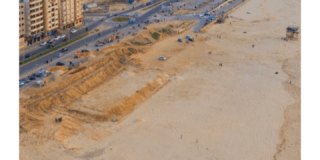Misery is manifold. The wretchedness of earth is multiform. Overreaching the wide horizon like the rainbow, its hues are as various as the hues of that arch, as distinct too, yet as intimately blended. Overreaching the wide horizon like the rainbow! How is it that from Beauty I have derived a type of unloveliness? — from the covenant of Peace, a simile of sorrow? But thus is it. And as, in ethics, Evil is a consequence of Good, so, in fact, out of Joy is sorrow born. Either the memory of past bliss is the anguish of to-day, or the agonies which are, have their origin in the ecstasies which might have been.
Edgar Allan Poe, “Berenice” Southern Literary Messenger, March 1835, 1:333-336
ABC News is reporting that Australian Foreign Minister Bob Carr has reassured the people of Solomon Islands that Australia will not let the country slide back into an ethnic war.
Senator Carr, speaking from the Solomons capital Honiara, said Australia remained committed to the people of Solomon Islands and their future:
We are not going to withdraw. And RAMSI’s [Regional Assistance Mission to Solomon Islands] police function is going to continue a long time after the military function is phased out
The Australian-led mission was deployed to Solomon Islands following five years of ethnic violence and a coup in 2000. The military component is likely to withdraw in the second half of 2013 as the focus shifts towards bilateral development aid.
How is it that from Beauty I have derived a type of unloveliness?
One of the darker aspects of corruption is its ability to derive unloveliness from beauty. Indeed in its darkest form, corruption seeks the most beautiful because the more beautiful and pure a thing is, the more satisfying it is to corrupt it.
When I studied art many years ago I was drawn to the beauty of the Leaning Tower of Pisa (Torre pendente di Pisa) or simply the Tower of Pisa (Torre di Pisa) a campanile, or freestanding bell tower. Construction of the tower occurred in three stages across 177 years. Work on the ground floor of the white marble campanile began on August 8, 1173, during a period of military success and prosperity. This ground floor is a blind arcade articulated by engaged columns with classical Corinthian capitals.
The tower began to sink after construction had progressed to the second floor in 1178. This was due to a mere three-meter foundation, set in weak, unstable subsoil, a design that was flawed from the beginning. I see the flaws in design and construction of what is otherwise a stunning work of art as analogous to RAMSI’s role in the Solomon Islands. Analogous in that nothing built on corrupt foundations can stand as intended or indeed even withstand the rigors of construction.
RAMSI whether the Australian Government and its Foreign Minister accept it as fact or not is built on weak and unstable subsoil. RAMSI’s formative acts included orchestrating a scheme to remove the lawfully appointed Attorney-General of the Solomon Islands Mr Julian Moti QC on trumped up and at the time of his arrest by Australian Federal Police (“AFP”) officers already discredited child sex tourism charges. However RAMSI’s and the AFP’s manipulation of the internal politics of a sovereign state, the Solomon Islands, went much further than the illegal removal of its Attorney-General.
Evil is a consequence of Good, so, in fact, out of Joy is sorrow born
Snyder Rini was the Solomons Prime Minister from April to May 2006. He was elected as Prime Minister by the Solomons Parliament on 18 April 2006, an event which caused wide spread unrest in Honiara with many locals claiming that the election was fixed and that Rini’s Government would be unduly influenced by local Chinese businessmen and by either or both of the mainland Chinese and the Republic of China (Taiwan) Governments. Originally to be sworn in as Prime Minister on 19 April, this was delayed until the following day because of the riots and was conducted without prior notice to avoid triggering further unrest. In response to the unrest, extra Australian, New Zealand and Fijian police and defence personnel were dispatched as part of RAMSI in an attempt to enable Rini’s Government to regain control.
On 26 April, Rini resigned immediately before facing a motion of no confidence in Parliament. The news of his resignation caused celebrations in the streets of Honiara. His successor, Manasseh Sogavare, took office on 4 May 2006, defeating Rini’s Deputy Prime Minister, Fred Fono, in the vote to replace Rini.
Fono, as Leader of the Opposition, named Rini as Shadow Minister of National Planning and Aid Coordination. After Sogavare was defeated in a no-confidence vote in December 2007, Rini became Minister for Finance and Treasury under Prime Minister Derek Sikua.
In response to the unrest which followed Rini’s election as Prime Minister, RAMSI police arrested and charged two members of the Solomons Parliament, Charles Dausabea and Nelson Ne’e, both of whom stood trial on charges alleging that they orchestrated the riots in April 2006. Former Solomons Foreign Minister Alex Bartlett (who had a large number of charges against him) also stood trial.
During the trial of Bartlett, Dausabea and Ne’e, the SI High Court heard about written agreements that the then Solomons Police Commissioner, Shane Castles (an AFP officer on secondment to the Solomons Police), made with two crucial prosecution witnesses. Pursuant to these agreements the witnesses received significant financial and other assistance on the condition they kept the agreements secret and gave evidence in Court only in accordance with their police statements. The agreements were in a form that violated judicial rulings on such matters and attempts to keep them secret clearly violated Solomons law governing disclosure of relevant information to defence lawyers.
Such a bungle in a high profile case in Australia would almost certainly have seen pressure on the Commissioner to resign for signing such damaging and foolish agreements. It was only following the issue of subpoenas that such payments came to light and there was reluctance on the part of the police to disclose. Again, the prosecution relied upon the worst type of witness (those who had a significant interest in giving evidence. They had much to gain by giving evidence – such as reduced sentence or financial reward). The three accused were acquitted of all charges. The further significance of the matter was the interest taken by Mick Keelty, Commissioner of the AFP, immediately following the riots and commenting upon the accused Charles Dausabea. Such comments appeared at the time to be in contravention of the recognized need for restraint on police and prosecutors commenting on the guilt or otherwise of individuals who are to face court. All three had spent significant periods on remand in highly political circumstances. The whole episode was in the context of the Julian Moti dispute waged between Australia and the Sogavare Government. This context included Australian Foreign Minister Downer writing an open letter to the people of the Solomons in which he attacked Mr Ne’e and Mr Dausabea.
The aforementioned agreements formed the basis of the subsequent civil action brought by Bartlett, Dausabea and Ne’e against the Commissioner of Police and the Director of Public Prosecutions, claiming that their prosecution was malicious and vexatious, arguing they were entitled to be compensated for wrongful arrest and detention as well as for defamation of character, reputation and standing.
The agonies which are, have their origin in the ecstasies which might have been
The actions of the AFP in paying witnesses in the Bartlett, Dausabea and Ne’e cases should not be viewed in isolation. They need to be viewed within the context of what appears to the standard extra-territorial modus operandi of the AFP.
On 15th September 2010 former Solomons public defender and Canberra-based lawyer Stephen Lawrence is reported in the Solomon Star, as saying that:
The ‘tension trials’ have been shameful and a comprehensive failure. Would RAMSI be quiet on convictions if they had good numbers to trumpet? Rather than objective notions of the rule of law, RAMSI’s criminal justice response became an attempt to achieve a form of political cleansing of those deemed to be at odds with Australia’s national interests. The rhetoric that Australia intervened to end the conflict is incorrect. The Australians came at least three years after the peak of violence when it became politically opportune in the broader context of a `war on terror’. Australia feared having a failed state on its doorstep, potentially leading to terrorist infiltration, refugee flows and transnational crime, as well as possible interference by a foreign power. A specific case of AFP bungling came to light on August 19 [2010], when Solomon Islands High Court judge David Cameron threw out evidence because AFP officers investigating a murder had “forgot” basic procedures, including reading the suspect their rights. [My emphasis]
While former Solomons public solicitor Ken Averre writing in State Society and Society in Melanesia Working Paper No. 2008/3 has commented that:
RAMSI have not been subjected to any real investigative scrutiny and have largely relied on a few journalists and civil society organisations, interested in police accountability, to avoid accountability or scrutiny. Any in-depth analysis or feedback is largely paid for by RAMSI themselves and AusAID send in “Technical Advisory Groups” to assess project/programme effectiveness but reserve a right of veto –presumably to ensure they do not end up looking too bad out of it. The question in the case of Solomon Islands would be what would be the reaction in Australia if a series of similarly high profile cases led to acquittals, following police bungles and impropriety? Resignations would be demanded. What have the AFP/RAMSI learned from these experiences? It has certainly not been to engage in a meaningful analysis of the problems and to consult with defence lawyers as to where the problems lie. It has been more to close ranks and become more reluctant in areas such as disclosure etc. [My emphasis]
While I’m not denying that some if not all of the people behind RAMSI in its conceptual stage may have been looking to create a work of art, I wonder what agony these people must feel when they look at what has become of a project that too many of its designers must have started out with such ecstasies. Their campanile in the South Pacific like the one in Pisa has been built on unstable and corrupt foundations and like its companion in Pisa is already starting to tilt, perhaps fatally. Australia has the potential to deliver untold benefits to our brothers and sisters in the South Pacific and elsewhere. The problem is that while the architectural drawing giving birth to this potential may be works of art, the foundations that Australia lays to build on are corrupt. These foundations invariably start with the AFP. No project, no matter how grand its design, can survive on corrupt foundations.
Does Australia have to potential to deliver great works to our brothers and sisters in the South Pacific? The answer has to be yes. Are the AFP the appropriate foundations on which to build these works? Well I let readers judge that for themselves. However if you were to ask Messers Moti, Ne’e, Bartlett and Dausabea I suspect the answer to my last question would be strongly in the negative.
By leaving the AFP in the Solomons as a policing presence, Australia is in effect burdening the people of the Solomons with the one arm of RAMSI that has the potential to do them the most harm in terms of lack of integrity and lack of accountability, while at the same time delivering them the least good.



It does appear that Carr is intending to leave to least desirable of Australia’s contribution to RAMSI in place. I pity the people of the Solomons.
I can’t believe that after everything the AFP have done in the Solomons that the intention of the Australian Government would/could be to leave them there – talk about neo-colonialism!
I pitty those poor bastards in the Solomons, fuck now they experience first hand excatly what every blackfella in Australia experiences every day of their lives – a corrupt and racist Australian Federal Police force – the white foot of oppression widens its area of control.
RAMSI as you say was designed with good intent, many of the people involved were people of good intent. The AFP as an organisation lacks good intent. Individual members may be of a high moral order, but organisationally the AFP is not. Really the AFP as an organisation needs to be subjected to more scruitiny and accountability.
Corruption is never acceptable. A nice synegy with your latest post. Eventually people will begin to realise just how corrupt the AFP really are!
No matter how good a design, if the builders, material or foundations are corrupt, the entire ediface is in danger of collapse. This is exactly what has happened to RAMSI because of the involvement of the AFP in what would otherwise have been a noble cause.
Hyppolite Jones the real problem, in fact the only problem is corruption in the AFP. As an organisation it cannot be trusted! Its self-centered, unaccountable and above/outside the rule of law. Is this a good thing for Australia?
The tower of Pisa a beautiful work of art. The AFP a creation of Satan!
There is really no excuse for the AFP’s conduct in Australia or else where. The time is right for some accountability!
There really does ned to be a Royal Commission into the AFP.
Yes Melissa Ogrady there does need to be a Royal Commission into the AFP. The sooner, the better!
Mark and Melissa Ogrady I’m 100% behind you on the need for a Royal Commission into the AFP.
More about AFP corruption. More reason why we need a Royal Commission into them!
RAMSI may have been built on good intent, but the AFP stripped it of every ounce of dignity it had!
I nice way of saying that the AFP are nothing more than a pack of corrupt bastards.
No good can ever come from corruption, no good at all.
The AFP, the corrupt sub-soil of Australia’s democracy.
Corruption and greed are indeed poor foundations to build something mmeaningful on.
Nothing of value grows on corrupt ground!
Yes sally, nothing lasting can be built on corrupt foundationa.
Nothing of any lasting value can be built on corrupt sub-soil.